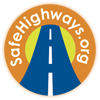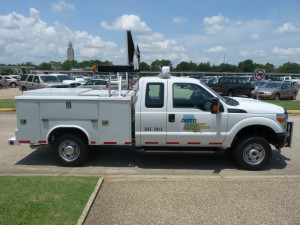News & Notes Winter 2011
NATIONWIDE
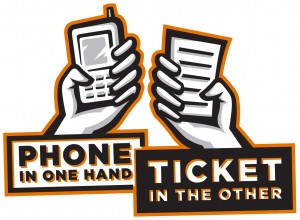 The National Highway Traffic Safety Administration reported that, following periods of increased enforcement and media campaigns, handheld cell phone use and texting while driving rates have dropped sharply in Syracuse, NY and Hartford, CT. In Syracuse, both incidences dropped 32%, and in Hartford, handheld cell phone use fell 57% and texting while driving dropped an amazing 72%. Transportation Secretary Ray LaHood states that “these findings show that strong laws, combined with highly visible police enforcement, can significantly reduce dangerous [behaviors] behind the wheel.”
The National Highway Traffic Safety Administration reported that, following periods of increased enforcement and media campaigns, handheld cell phone use and texting while driving rates have dropped sharply in Syracuse, NY and Hartford, CT. In Syracuse, both incidences dropped 32%, and in Hartford, handheld cell phone use fell 57% and texting while driving dropped an amazing 72%. Transportation Secretary Ray LaHood states that “these findings show that strong laws, combined with highly visible police enforcement, can significantly reduce dangerous [behaviors] behind the wheel.”
These pilot programs are called “Phone in One Hand, Ticket in the Other” and are modeled after the successful “Click it or Ticket” seat-belt campaigns. These programs consist of four waves of police crackdowns and education programs, and play an important role in convincing the Governors Highway Safety Association to change their stance on the effectiveness of such laws. The GHSA had advised 41 states against adopting bans until more research had been done. With the promising results from these pilot programs, there is now evidence to back the implementation of cell phone usage bans.
CALIFORNIA
The Bay Area’s Freeway Service Patrol will fill in a gap in the program’s coverage area by expanding to a new 20-mile segment along Interstate 280 between State Routes 92 and 85. Two trucks have been assigned to the new coverage area and will patrol from 6 a.m. – 9 a.m., and 3:30 p.m. – 6:30 p.m., Monday through Friday. Drivers will repair vehicles, including change tires, jump-start batteries, provide fuel, clear accidents and remove debris from the roads. The Bay Area FSP averages 11,000 stops a month to help motorists. It is paid for by federal, state and local funds, and is overseen by the Metropolitan Transportation Commission.
FLORIDA
On May 6, 2011, Todd Stettler was on duty patrolling the Veterans Expressway when he came across a motorist pulled over on the side of the roadway. The motorist, Nelson Melendez, was not feeling well and had pulled to the side of the highway to rest. He explained this to Todd and told him he just wanted to wait a couple of minutes before moving on.
Todd remained behind the vehicle for a few more moments. He checked on Melendez again, who stated he would be alright, but Todd determined that he should call 911 for Melendez’ health and safety. The paramedics showed up and determined that Melendez was suffering from cardiac arrest and needed immediate attention. Three days later, Melendez underwent quadruple bypass surgery; four arteries had been 98 to 100 percent blocked.
In the weeks following, the responding paramedics visited Melendez and explained to him that had it not been for Road Ranger Todd’s actions, Melendez likely would not have survived.
Todd, a contracted employee of Anchor Towing and Marine Transport, has been cited as an exemplary Road Ranger, taking great pride in providing great customer service to motorists, and in assisting the Florida Highway Patrol at incident scenes. Todd has been a Road Ranger for 5 years in the Tampa area and has been a Road Ranger Operator on the Florida’s Turnpike Enterprise’s Veterans Expressway/Toll 589 since September 2010.
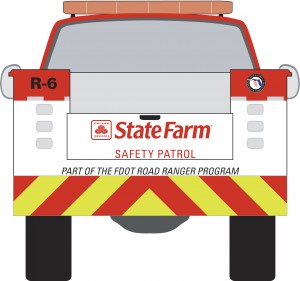
Florida’s Turnpike’s State Farm Safety Patrol vehicles’ new look, includes rear high-visibility markings.
Florida’s Turnpike State Farm Safety Patrol Road Ranger trucks are starting to have a new look thanks to collaboration between Herbie Bush from contractor Florida Turnpike Services and State Farm.
The new whiter, brighter look involves eliminating much of the red vinyl from the truck hoods, which discolors and peels from sun and engine heat, and from the truck roofs, which also becomes discolored and is rarely seen by motorists. Removing this vinyl reduces maintenance costs and has the additional benefit of reducing the heat load on the trucks’ passenger and engine compartments.
Additional changes include rear high-visibility markings, similar to the chevrons on newer fire apparatus. The NFPA 1901 standard requires that at least 50 percent of the rear-facing vertical surface of automotive fire apparatus must be covered with 6-inch reflective red, yellow, fluorescent yellow or fluorescent yellow-green material. The State Farm Safety Patrol trucks are now adding red and yellow high-visibility markings to new vehicles and are working toward increasing the markings to reach the NFPA fire apparatus standard.
GEORGIA
In June 2011, a Georgia Department of Transportation H.E.R.O. operator was struck and injured by a tractor-trailer on Interstate 85. The H.E.R.O. operator was injured while clearing an inner lane of tire debris. A tractor-trailer hit two vehicle which had stopped for the H.E.R.O. operator and then struck the operator. The operator was sent to the hospital with several broken bones, but will recover.

GDOT issued an advisory in June for motorists traveling in Atlanta to look out for a H.E.R.O. patrol impersonator.
Also in June, the Georgia DOT issued a warning that scam artists were trying to take advantage of stranded drivers by pretending to be H.E.R.O. operators. This cautionary advisory stems from an incident on June 1, when a driver had a flat tire on Interstate 75 in Atlanta and was approached by a Dodge pick-up truck whose driver claimed he was a DOT employee. The man took the driver’s wheel rim and $100, promising to return with a new tire, but never returned. DOT officials are warning drivers to check for DOT identification if they are approached and to remember that HERO operators do not charge for assistance and will not solicit tips or rewards.
INDIANA
Indiana DOT’s Hoosier Helper Freeway Service Patrol was recently awarded the 2011 Indiana Excellence in GIS Award. The Indiana Geographic Information Council reports Indiana DOT’s need to evaluate the benefits of the Hoosier Helper program in order to justify funding for the program. Using geographic information systems (GIS), Indiana DOT developed a way to graphically illustrate the effects Hoosier Helpers have on traffic and safety, including the impact the program has on air quality, fuel savings and traveler delay. The analysis also allowed both current and historical data to be examined and for incident profiling graphs to be created as data checkpoints. As a result of the analysis INDOT was successful in a bid for more than $1 million in Federal Congestion Mitigation and Air Quality (CMAQ) funding for Hoosier Helpers.
KANSAS

KTA and State Farm announced the launch of the Summer 2011 State Farm Safety Assist program. Above two assisted motorists share their story.
In May, just in time for Memorial Day Weekend, the Kansas Turnpike Authority and State Farm Insurance announced the launch of the second year of the State Farm Safety Assist summer program. Six patrol cars assigned to the Kansas Turnpike will patrol during peak hours, which will help motorists who have broken down, run out of gas, stranded, etc. According to Ramon Smith, District Agent for State Farm Insurance, this partnership is “an obvious, natural fit,” and its benefits can be seen immediately. Two motorists who received assistance from the State Farm Safety Assist patrol last year also spoke at the event. As a compliment to the launch announcement, a safety exhibition was held at the Belle Plain Service Plaza featuring information on child safety seat checks, disaster kit making and drunk driving.
LOUISIANA
The Louisiana Department of Transportation and Development’s (DOTD) Motorist Assistance Patrol (MAP) announced improvements to the MAP vehicles in mid-July. In place of vans, the program will not utilize extended-cab trucks. The new trucks will help to provide better assistance to stranded motorists and will travel better over rough terrain and in construction zones. Baton Rouge was the first to activate the new trucks, New Orleans will follow and then Shreveport. “Each truck is outfitted with storage compartments on each side, allowing the operator to access equipment and supplies on either side and stay clear of traffic,” said DOTD Intelligent Traffic System Direct, Steve Glascock. “It provides a great deal of added safety and convenience for our drivers and the public.”
MARYLAND
 Sponsorship of Maryland’s State Highway Administration Emergency Patrol moved forward in June with the erection of informative highway signs on the patrol’s covered routes. The new signs are part of the three-year pilot sponsorship program for emergency response patrols. The $1.3 million sponsorship was approved in December by The Board of Public Works, and State Farm paid for new signs to be placed around the state, increasing program awareness. In addition, the sponsorship funds will allow the emergency response vehicles to provide more night/overnight coverage, buy additional vehicles, and improve safety equipment.
Sponsorship of Maryland’s State Highway Administration Emergency Patrol moved forward in June with the erection of informative highway signs on the patrol’s covered routes. The new signs are part of the three-year pilot sponsorship program for emergency response patrols. The $1.3 million sponsorship was approved in December by The Board of Public Works, and State Farm paid for new signs to be placed around the state, increasing program awareness. In addition, the sponsorship funds will allow the emergency response vehicles to provide more night/overnight coverage, buy additional vehicles, and improve safety equipment.
NORTH CAROLINA
North Carolina DOT’s Incident Management Assistance Patrol (IMAP) recently expanded its patrol coverage area to include I-85 in Davidson County. The expansion closes a gap between Charlotte and Raleigh and also includes Randolph and Rowan counties. The new coverage area is currently being patrolled on weekdays from 5:30 a.m. to 9:30 p.m., but North Carolina DOT plans to expand coverage hours to include the weekends starting in September.
NEW JERSEY
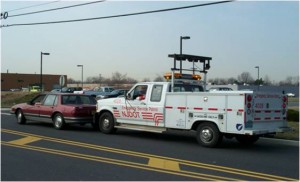
NJDOT SSP vehicles may have a new look soon when legislation passes allowing sponsorship of the program. Image courtesy of NJDOT.
The Senate Transportation Committee, the Senate Budget and Appropriations Committee and the full Senate have approved legislation that will allow both toll booth advertising and the use of private funding as payment for safety patrol services. The first bill (S-2182) of two bills sponsored by Senators Donald Norcross and Jim Beach is directed at the New Jersey Turnpike Authority and the South Jersey Transportation Authority, and authorizes commercial advertising and sponsorship signs on toll collection equipment. The second bill (S-2787) would allow the Department of Transportation to use safety service patrols and emergency service patrol vehicles and equipment as advertising opportunities. In this way, the Department can partner with private entities, which will offset the additional costs of operating safety patrol vehicles by transferring them from the public to private funds. The bills are awaiting final authorization by the Governor.
In Memoriam
Tennessee DOT’s HELP program lost one of its own on June 20, 2011. HELP driver, former NYPD officer and 9/11 first responder, Robert Nowicki was fatally injured in the line of duty. Nowicki was assisting a stalled big rig on the side of I-55 south in Arkansas, when he was struck by another semi. John Thomas with TDOT says of Nowicki, “He has a wife and four kids. His whole career was as a first responder with either the HELP program, (as) a police officer for the city of New York or (as a) Marine. His career was helping people.” In 2006 Nowicki joined the TDOT and was recognized in 2009 for helping deliver a baby along the highway. He is the first member of a HELP team killed in the line of duty since the program started in 1999 in Tennessee’s four major urban areas. A memorial mass was held for Nowicki on July 23, 2011 at Our Lady Queens of Maryrs in Centerport, NY. Truckers in the Memphis, TN area also honored Norwicki in July by creating a caravan of rigs representing dozens of wrecker companies in Memphis. “We are deeply saddened by the loss of Robert Nowicki and our hearts and prayers are with his family,” TDOT Commissioner John Schroer said in a statement.
